
|
Sale 8
Coin and Currency Auction
| Lot |
Photo |
Description |
Realized |
Lot 101 |
 |
1795 Talbot, Allum & Lee Token Cent. PCGS graded MS-65 Red and Brown. Full mint red toning to brown with traces of darker toning, mostly on the obverse which displays a long vertical die crack left of Liberty. A common type but rarely seen with this much mint color. Tied with a total of 3 as the finest graded by PCGS, only a single coin qualifies for full "Red", that being an MS-64. With this much original red, it is likely that this is the best to survive.
Estimated Value $1,500 - 2,500.
View details and enlarged photos
| Realized
$1,840 |
Lot 102 |
 |
1795 Talbot, Allum & Lee Token Cent. PCGS graded MS-63 Red and Brown. Nearly full mint red, with just a bit of mellowing on the obverse, makes this a very rare condition indeed. The reverse has more toning, but retains most of the original red in abundance. We note a minor planchet flake (still attached) from the rim just missing the bottom left of the L of LIBERTY. One minor spot over the E of COMMERCE. On the reverse, there is some minor raised black verdigris hidden in the ships rigging, and scattered in a few of the letters (this is minor). An important type coin to find in such high grade.
Estimated Value $750 - 1,000.
No provenance information was provided, but likely purchased in the 1940s.
View details and enlarged photos
| Realized
$920 |
Lot 103 |
|
1795 Talbot, Allum & Lee Token Cent. PCGS graded MS-63 Brown. Satiny brown luster and sharply struck on a clean planchet. Well struck on the ship and with one faint fingerprint on the reverse. Nice for the grade.
Estimated Value $700 - 900.
View details
| Realized
$863 |
Lot 104 |
 |
1796 Castorland Silver Medal. Unbroken die. PCGS graded AU-55. One of the original medals struck in Paris for a proposed colony in New York. As the French Revolution unfolded in 1792, many people desired a more peaceful existence, and a company was formed to sell French expatriates land in upper New York. The founders of the company apparently stole most of the money, and the few settlers met with exceptional hardships due to the severe winter of 1794-5, and again the following year. Many left the area and moved to Louisiana and elsewhere. Eventually, the company folded. Nevertheless, these coins were struck, and being good silver circulated for many years. This particular coin boasts a choice antique gray tone, with boldly struck devices on both sides. A glass will note a few scattered handling marks, but nothing of consequence. One of the more beautiful of the colonial issues, and worthy of a high bid.
Estimated Value $3,500 - 4,000.
Purchased from Ira S. Reed 5/16/45 for $35.00 as "Orig. Unc."
View details and enlarged photos
| Realized
$3,450 |
Lot 105 |
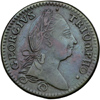 |
1783 Georgius Triumpho Token. VF-35. The obverse die was apparently taken from a rude head of George III, as in 1783 there were no available portraits of Washington to copy. Struck in 1783 as the victorious Washington had recently prevailed over superior British forces, the reverse depicts Liberty weaving her new flag, with the fleurs de lys alluding to the French help in winning the Revolutionary War.
There is a curious red streak along the back of Georgius's head, and another through his jaw to the right rim. The surfaces have been waxed to preserve them. On the reverse, it has been cleaned, and is now toned a light pinkish copper color, with some minor surface roughness noted. Always popular with collectors.
Estimated Value $250 - 350.
Purchased from Stack's on 10/21/44 for $5.25.
View details and enlarged photos
| Realized
$437 |
Lot 106 |
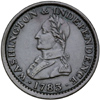 |
1783 Washington Token. Small military bust, plain edge. VF-35. Deep brown in color, with some minor verdigris in the lettering and devices. Struck around 1810-1820.
Estimated Value $100 - 150.
No provenance information included, but likely from the 1940s.
View details and enlarged photos
| Realized
$121 |
Lot 107 |
 |
1783 Washington Token. Small military bust, engrailed edge. PCGS graded AU-55 (c. 1810-1820). These were struck at the Soho, Birmingham Mint, and designed and engraved by Thomas Wells Ingram, after Edward Savage. Deep brown copper color throughout, and well struck for this variety. Radial die cracks on the obverse, as well as through the lower letters. The reverse die is lightly clashed through the seated Liberty's head into the field. An exceptionally nice coin that is seldom encountered this nice, in fact the PCGS Population Report shows only 3 coins graded this high, with 2 graded higher of the variety.
Estimated Value $750 - 1,250.
Purchased 10/21/44 from Stack's at $4.10.
View details and enlarged photos
| Realized
$1,035 |
Lot 108 |
|
1783 Washington Token. Copper restrike, engrailed edge. PCGS graded Proof 67 Brown. Baker-3. It is not known exactly when this was restruck, possibly the 1860's when they were widely collected, or as early as 1820. The date 1783 refers to the Treaty Of Paris. Well made and with fully struck devices. The dies show a bit of rust on Washington. Superb surfaces and one of the two finest graded by PCGS, don't pass this up.
Estimated Value $2,000 - 2,500.
View details
| Unsold |
Lot 109 |
 |
1783 Washington Token. Copper restrike, engrailed edge. PCGS graded Proof 64 Brown. Lovely subdued medium chocolate brown with traces of mint red around the periphery. Left of the date is a carbon spot and on the portrait is faint evidence of more carbon. Another beautiful coin, thought to have been struck around 1860.
Estimated Value $500 - 750.
View details and enlarged photos
| Realized
$529 |
Lot 110 |
 |
1783 Washington Token. Copper restrike, engrailed edge. PCGS graded Proof 63 Brown. Thought to have been struck around 1860, this popular restrike displays President Washington in a portrait that resembles Napoleon Bonaparte. No button on Washington's toga. The reverse is a seated Liberty, with a cap of freedom extended on a long pole. On the obverse, substantial mint red adheres near Washington and the lettering, while the reverse shows a curious reddish cross over Liberty, rim to rim, with the fields divided up in quarters by greenish hazy toning. As a proof, the coin is very sharply struck, and free of all but minor hairlines in the fields.
Estimated Value $500 - 700.
Purchased from Stack's 10/21/44 for $5.
View details and enlarged photos
| Realized
$489 |
Lot 111 |
 |
1783 Washington Token. "UNITY STATES". PCGS graded AU-55. Struck around 1810-1820 with the obvious copy from existing large cents, these pieces had specially prepared planchets with striations around the edge to simulate circulation and facilitate acceptance. Fewer striations than usually encountered, with the legends still clear. One of 14 so graded by PCGS, with just 6 coins graded higher for this important variety. An excellent tie-in for large cent collectors, and an important Washington piece.
Estimated Value $750 - 1,000.
Purchased 10/21/44 from Stack's for $3.50 as "Very Fine".
View details and enlarged photos
| Realized
$604 |
Lot 112 |
 |
1783 Washington Token. "UNITY STATES". PCGS graded AU-53. Medium chocolate brown in color and well struck. With the usual striations around the edge of the planchet, done prior to striking, in order to simulate wear and ease acceptance into circulation. Spot and problem free, with clean fields and devices. One very minor scratch down Washington's face, visible with a glass. The reverse planchet striation lines extend at a sharp angle around the entire edge of the coin, but the lettering and devices are still present.
Estimated Value $700 - 900.
Purchased 7/21/44 from Ira S. Reed for $2.
View details and enlarged photos
| Realized
$529 |
Lot 113 |
 |
(c.1783) Washington Token Double Head Cent. PCGS graded AU-58. Well struck and preserved, with full details on the upper devices, including the epaulets. Although the designer and engraver are unknown, this is likely a Birmingham product. Light brown in color, with some darker highlights in the lettering and devices. One of only 7 so graded by PCGS, with just 4 coins graded higher. Probably struck around 1810-20.
Estimated Value $600 - 800.
No provenance information included, but likely purchased in the 1940s.
View details and enlarged photos
| Realized
$604 |
Lot 114 |
 |
1791 Washington Token Cent. Large eagle. PCGS graded MS-64 Brown. This coin was made by the Birmingham token manufacturer Obadiah Westwood, and engraved by child prodigy John Gregory Hancock, Sr. Issued in order to win the contract for coinage in America, Breen estimates that a cask containing 2,500 large eagle and 1,500 small eagle cents was shipped to Philadelphia to the Westwood's representatives, Thomas Ketland & Sons for distribution to cabinet officials, dignitaries, senators and other VIP's. Some of these coins found an audience with President Washington, who rejected the proposal as "monarchical" and also noted that he was against contract coinage of any kind, especially from outside the country. One of the most beautiful of Hancock's coins, this is certain to attract considerable attention from all serious Washington and Colonial collectors.
Superbly struck, even on the epaulets on Washington's shoulder, as well as his upper curls, the reverse too, with full definition on the eagle, head to claw. Delightful brown toning, with hints of original red in the lettering, and free of spots or any significant contact marks. A couple of very minor ticks are noted on Washington's face. Simply a superb coin that boasts an excellent appearance and abundant eye appeal. According to a recent PCGS Population Report, only 10 have been graded this high, with none graded higher.
Estimated Value $1,750 - 2,500.
No provenance information included, but likely purchased in the 1940s.
View details and enlarged photos
| Realized
$2,415 |
Lot 115 |
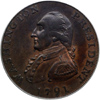 |
1791 Washington Token Cent. Large eagle. PCGS graded MS-64 Brown. With blunt striking on the highest parts of the hair and in the area of the lower end of the shield. Beautiful dark chocolate brown surfaces with a considerable amount of mint red. One of the finest graded of this variety, of which PCGS has graded 10 as such, with 3 more in Red Brown, and only a single coin graded higher. For the specialist in Washington pieces.
Estimated Value $1,750 - 2,500.
View details and enlarged photos
| Realized
$1,725 |
Lot 116 |
 |
1791 Washington Token Cent. Small eagle. PCGS graded MS-65 Red and Brown. A stunning coin that boasts some of the original mint red adhering near the lettering and devices on both sides. Boldly struck, with full details on Washington's epaulets, and on each of the eagle's tiny feathers. Free of nearly any signs of contact, the only we could locate is a tiny hidden mark on the star behind the eagle's head, which can serve to trace this specimen. Certainly one of the finest known of the variety, PCGS has only graded 2 coins in Red and Brown, both the same grade, with none graded higher or lower. More available in toned brown condition, but still extremely rare in this grade. To be highly critical, there are some minute specks on both sides, none important or distracting. A prize who's rarity and desirability can scarcely be overstated.
Breen estimates the original mintage of 1,500+ pieces. This design is one of the more available of John Gregory Hancock, Sr.'s masterful works. The portrait of George Washington is thought to have been copied from an engraved copy of Pierre Eugène DuSimitière's drawing, and the portrait is quite becoming. On the reverse, the design obviously copies the Great Seal of the United States, but note how Hancock arranged the clouds, on the Great Seal, the clouds form a small circle over the eagle's head, here on this coin, Hancock spreads the clouds out, extending them in a natural arc from wing to wing. Handling the clouds in this manner provides balance to the coin design, and this important design element was copied by Robert Scot at the Philadelphia Mint when he engraved the heraldic eagle reverses starting in 1798, rather than placing the stars within a circle of clouds over the eagle. The heraldic eagle reverse design was used on all silver and gold denominations from 1798 until 1807 or so, as well as on a few back dated half eagle and eagle issues from 1795-1797 and quarter eagles from 1796 until 1807.
Estimated Value $3,000 - 5,000.
No provenance information included, but likely purchased in the mid 1940s.
View details and enlarged photos
| Realized
$5,750 |
Lot 117 |
|
1791 Washington Token. Liverpool Halfpenny. PCGS graded AU-50. A few handling marks on each side, and with deep brown color throughout. This one lightly circulated and is well preserved. Minor weakness on the right side of the ship.
Estimated Value $2,000 - 3,000.
View details
| Unsold |
Lot 118 |
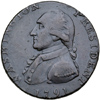 |
1791 Washington Token. Liverpool Halfpenny. PCGS graded EF-40. An extremely rare coin that is seldom found in any grade (Breen 1223). Breen estimates that only 20 are known in all grades. PCGS has only graded 6 so far, with none graded higher than AU-55. Dark brown in the fields, with the devices a bit lighter. These were all struck on planchets which were a bit small, and the tops of the lettering are always missing on the few known specimens. No scratches, surface marks or edge bruises and very choice for the grade assigned. The reverse die shows the diagnostic lump on the mainmast (near the top) and minor die rust as always seen. The edge device reads PAYABLE IN ANGLESEY LONDON OR LIVERPOOL, but is obscured by the PCGS holder. An important coin which has been listed in the Guide Book for many years. This one has been off the market for over 55 years. Nearly identical to the example offered in Stack's famous John L. Roper, 2nd Sale, December 1983, lot 374, but this is a different specimen.
This is an early example of John Gregory Hancock, Sr., die engraving. Hancock used an engraved copy of Pierre Eugène DuSimitière's drawing of Washington for the portrait device. As to why the planchets used were too small for the dies remains a mystery. Perhaps this was a small trial run, with only 20 or so known today, it would seem likely that these were not made for import, but for local collectors or as patterns.
Estimated Value $1,500 - 2,500.
Purchased from Ira S. Reed on 12/14/45 for $100.
View details and enlarged photos
| Realized
$3,220 |
Lot 119 |
 |
1792 Washington Copper Token. Eagle with stars on reverse, lettered edge. Baker-21. EF-40. The surfaces are a medium chocolate brown in color, although the coin was lightly silvered, most of which has worn away (less than fifteen percent of the surfaces show silvering) in subsequent circulation. Perhaps silvered to provide a visual aid to Congress and to demonstrate the usefulness of W. and Alex Walkers (Birmingham merchants) proposed copper, silver and gold coinage denominations, all produced by the same pair of dies. The silvering remains only in the protected areas, near the devices and lettering. Surprisingly well struck as the devices are deeply cut into the dies, even the epaulets on Washington's shoulders show complete and exacting detail, despite light wear from circulation. Further, the highest curls on Washington's wig remain crisp and complete in definition. A tiny centering dot can be seen just above Washington's collar below and slightly left of his earlobe. Similar on the reverse, the eagle retains magnificent and glorious feather separation on its wings, tail and head. Even the minute details of its knobby legs are present. This is where the genius of the engraver John Gregory Hancock, Sr. shines, the central shield received most of the wear, but rather than engrave fine pales and gules in the shield (which would offer little defense against circulation and wear), Hancock engraved wide, deep lines which would not show wear until after extensive circulation. Curiously, the reeding around the edge is very shallow, and the planchets appear to be too small for the dies. Reeding protects the central devices from wear, a problem on the 1793 half cents and cents (which used much smaller edge beading instead), without the surrounding edge reeding to protect the central design, coins tend to wear much quicker after limited circulation. Engraving devices which could receive wear (reeding, or in this case a thick central shield) while the fine details were preserved (the eagle's wing feathers and tail feathers) is the genius of the sixteen year old engraver, Hancock.
Close examination will note a faint series of scratches forming a grid pattern in the left obverse field, and more continue above Washington's head as well as a few vertical ones in the right field. The reverse also has a few, but they are very faint. The scratches are old, toned over and while present, are not too troublesome. There is a tiny planchet defect touching the outer edge of D of PRESIDENT from the rim, and this should help to trace the pedigree of this coin.
Breen reports 4-6 known with the lettered edge (Br-1229), and another 6 or 7 known with a plain edge. The only other offering of a lettered edge coin is the "nearly Fine" piece in the Garrett Sale (Bowers and Ruddy, 3/81:1712; later Stack's Roper Sale, 12/83:380) the Bowers cataloger stated "only about a half dozen are known" but offered no other information on known specimens. In the Roper Sale, Stack's estimated that 8 to 10 copper specimens are known including lettered and plain edge varieties. None have been offered in recent years, and this important issue is undoubtedly extremely rare. Neither Norweb or Eliasberg had a specimen. The copper examples apparently circulated along with other Washington pieces, as well as large cents once the Philadelphia Mint began producing coins. Survival was random, and no condition census exists that we could locate. Nevertheless, this coin is certainly one of the finest of the few known, hidden off the market for over 55 years.
The story behind the creation of this coin is fascinating. One of the most important of the series of Washington pieces is the Hancock multidenominational pattern offered here. They were designed by John Gregory Hancock, Sr., a juvenile engraving prodigy who was working for a Birmingham, England token manufacturer. Hancock became one of the finest artists in the history of 18th century British diemaking and earned his reputation well. One of Hancock's honored tasks was being chosen to make dies for cents portraying George Washington as samples for a proposed federal coinage contract. Hancock had already made a name for himself in America by designing the 1791 Washington, large eagle cents. It is believed that about 4,000 of the 1791 cents arrived in America, and these were distributed to dignitaries and officials in hopes of winning the contract to produce coinage for the new United States.
During 1791 proposals were discussed in Congress to establish a mint in America, or purchase contract coinage from the technically superior and cutting edge firm of Boulton & Watt (Birmingham, England), including negotiations with a would-be representative of Boulton, one John Hinkley Mitchell, who seems to have had in mind establishment of a subsidiary or agency of Boulton in the USA (Breen). Meanwhile Jefferson way trying to induce Swiss engraver John Pierre Droz to move to Philadelphia and become Engraver or even Director of the proposed federal mint, leaving behind his employment at Boulton & Watt. Last but not least, we have Messrs. W. and Alex. Walker, Birmingham merchants, who ordered sample cents of two designs to be struck by Obadiah Westwood's private mint in that city, with dies by Hancock. Some solution was urgently needed.
Heated words flew back and forth as Congress debated the proposals for creating much needed coinage. Thomas Paine passionately opposed private contract coinage, especially of foreign origin using foreign copper. Thomas Jefferson listened well, and helped to have Paine's arguments published in the National Gazette 10/17/1791 and in American Magazine 10/1791 (Breen). Apparently Jefferson convinced George Washington that the best solution was to establish a federal mint.
Meanwhile, Congress was debating the Morris coinage bill which would have established a federal mint and a coinage system. In addition to establishing a mint, the Morris bill proposed that the coins would "portray Pres. Washington" (Breen) and because of this section, Hancock's employers submitted these copper coins for consideration to win the coinage contract. Winning an important coinage contract would be very lucrative for the backers.
Meanwhile, President Washington reportedly saw his image on some of the 1791 Hancock coins and stated that the designs were too "monarchical" and rejected the idea of his image being placed on coins. The Morris bill was rewritten, and in its final form (which became law on April 2, 1792) the coins instead called for "an impression emblematic of Liberty". With international communications slow, Hancock did not learn of the change in the Morris bill, or of Washington's disapproval, until these new dies had been engraved and a few coins struck.
Hancock and his backers (W. and Alex Walker) believed that these dies could be used interchangeably to produce copper coins worth approximately one cent, silver coins worth approximately half a dollar, and a gold piece worth ten dollars, although no weight standard had been set at the time for denominations. A single gold example exists in the Newman Collection, less than 10 silver pieces are known, some with a lettered edge, others plain; and less than a dozen copper coins are known, some with plain edge (6-7) and lettered edge (4-6) according to Breen. This coin has the lettered edge UNITED STATES OF AMERICA .X.
When word finally reached Hancock that Washington didn't want his portrait on coins and that the Morris bill had passed establishing a federal mint, Hancock undertook an extraordinary piece of revenge. Washington's spokesman had compared the idea of presidential portraits on coins to the practices of Nero, Caligula and Cromwell, so Hancock's (and/or Westwood, his employer) idea was to portray Washington on a coin as a degenerate, effeminate Roman emperor. The "Roman Head" cents are one of Hancock's masterpieces, albeit a satirical piece. Of the Roman Head coins, approximately a dozen were made and given out very quietly to Hancock's and Westwood's friends. These remained a secret for over 40 years, lest their discovery touch off an "international incident". (Breen)
Thus, the rejection of this coin design and failure to obtain the contract coinage agreement led to creation of the "Roman Head" cent by Hancock. The coin offered here is one of the most coveted and rare of the Washington pieces, and certain to bring a runaway price from a true numismatist that understands the immense historical importance of this coin.
Estimated Value $15,000-UP.
Ex: Ira S. Reed, 11/21/45 at a then staggering cost of $125.
View details and enlarged photos
| Realized
$48,300 |
Lot 120 |
|
Withdrawn
| Unsold |
Lot 121 |
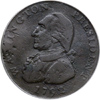 |
(1792) Washington Token Cent. "WASHINGTON PRESIDENT", plain edge. SEGS graded Fine-15 "Light Roughness". The obverse has a few marks on the SH of WASHINGTON and the reverse appears to be slightly bent, after which the coin circulated and wore unevenly. Approximately two-thirds of the letters are visible on the reverse. It is apparent from the survivors of John Hancock's patterns that they obviously circulated widely. Most are in low grades. This one also has minor roughness. An important coin that will no doubt find many appreciative collectors bidding for it.
Estimated Value $2,000 - 3,000.
View details and enlarged photos
| Unsold |
Lot 122 |
|
1792 Washington Copper Token. Small eagle. Baker-25, Breen-1352. PCGS graded VF-30. An extremely rare example of this enormously popular trial piece. These were designed by Peter Getz, after the trials coins submitted by engraver John Gregory Hancock, Sr. The Getz pieces were struck in Philadelphia at Harper's Coach House, on Sixth Street. Restrikes were made later, but the dies had rusted, this is an original piece struck before the die rust appears at the A of STATES and in the stars below. Noted to be "rare" in the Breen Encyclopedia, this has been confirmed by the very few offerings over the decades. Only 6 have been graded by PCGS, 5 between VG and VF, and one coin graded EF-45. Apparently these circulated rather than being set aside as souvenirs.
The surfaces show smooth, even wear, and are a pleasant dark chocolate brown. Identifiable by a small planchet flake near the G below the bust, and a smaller one below the back tip of his bust also close to the rim. The design appears to be quickly rendered, and precious few dentils exist to protect the devices from wear, and hence some wear is noted on the peripheral lettering. Struck like a medal, so when the coin is turned over, it is done from right to left, rather than top to bottom. On the reverse, the die was hastily executed too, and this one is struck a hair off center towards 4 o'clock, with the tops of the letters AMERICA off the edge a bit. Remarkably clean surfaces for the grade, no annoying corrosion or spots, just light wear and even brown color throughout. Furthermore, the rims are free of bangs and bumps, and one almost wonders if this was some prized pocket piece (Washington and his ever deeper pockets?) that was kept apart from other coins as the surfaces are just to perfect. Aaah, the joys of speculation!
A boldly struck and exciting example of this rare pattern issue.
Estimated Value $10,000 - 12,000.
View details
| Realized
$14,950 |
Lot 123 |
|
1792 Washington Copper Token. Small eagle, design by Peter Getz. Baker-25, Breen-1352. PCGS graded VF-20. Here is another example of this rare and desirable coin. Only 6 have been graded by PCGS, this a rather nice VF-20 example. Examination with a glass will note some minor surfaces marks perhaps from a brief day on the ground before being found. The marks are irregular in shape and size, and scarcely visible. A few surface scrapes and scratches can also be seen, but they are minor and expected for a large coin of this era. On the reverse there are a couple of pin scratches below UNITED in the field, and a minor rim ding over the CA of AMERICA. The obverse lettering is worn, and most of it can still be made out. This one apparently circulated for many years, before being saved, along with the profusion of other Washington pieces. Struck in Philadelphia around 1791-2, and a very important issue for the colonial and Washington specialist.
Estimated Value $8,000 - 10,000.
View details
| Realized
$8,625 |
Lot 124 |
|
1793 Washington Token Halfpenny. Ship reverse, lettered edge. PCGS graded AU-55. Weight 168.2 grains. Dark chocolate brown in color with nice surfaces and rims. There is a small chip out of the planchet on Washington's shirt, just above his collar. Slight weakness in the strike on Washington's curls, but sharp on the epaulets and on the reverse too, including the ship rigging. On balance, this is an exceptional example of this rare issue, only 4 have been graded higher by PCGS. Rare and desirable in every way.
Estimated Value $700 - 900.
View details
| Realized
$776 |
Lot 125 |
 |
1793 Washington Token Halfpenny. Ship reverse, lettered edge. PCGS graded AU-53. A middle die state before the dies badly clashed and buckled, but with minor die rust noted in the lettering. Deep chocolate brown in color, with smooth even wear and free of spots or dents. As with most other coins from this Birmingham token mint, the devices are boldly struck and the coin is very well executed. Examination with a glass will scarcely note any circulation marks. An outstanding example of this popular Hancock Birmingham Mint issue.
Estimated Value $600 - 800.
No provenance information included, but likely purchased in the 1940s.
View details and enlarged photos
| Realized
$575 |
Lot 126 |
|
1793 Washington Token Halfpenny. Ship reverse, lettered edge. PCGS graded AU-53. Medium brown in color with clean surfaces throughout. Sharply struck on all but the highest parts of Washington, which also include some minimal wear on his curls and epaulets. On the reverse, there is a weak area at the center of the ship (normally weak) as this was opposite Washington's shoulder. Seldom found in full mint state, this nice AU example should attract well deserved interest from Washington collectors.
Estimated Value $600 - 800.
View details
| Realized
$575 |
Lot 127 |
 |
1795 Washington Token. Grate reverse, large buttons, reeded edge. PCGS graded MS-63 Red and Brown. The obverse has a lovely portrait of George Washington, dressed in full uniform surrounded by the wording G. WASHINGTON. THE FIRM FRIEND TO PEACE & HUMANITY. The reverse depicts a grate, surrounded by PAYABLE BY CLARK & HARRIS.13. WORMWOOD ST. BISHOPSGATE. With LONDON 1795 below the grate. The color ranges from original deep red in the lettering and devices to deep blue in the fields. Boldly struck by the dies, and the only weakness is noted on the O of LONDON, which is opposite the high point of the obverse die. We also note a very minor scrape on the lower reverse from the grate down to the first digit of the date and a similar minor disturbance near the L of LONDON. A beautiful coin that will delight the collector.
Designed and engraved by Thomas Wyon, and struck at Kempson's Mint, Birmingham. Word had leaked back to England by 1795 that the Philadelphia Mint was in trouble, and could soon be abolished. The Birmingham token makers quickly produced considerable quantities of these as sample coins to be given to legislators and Cabinet members in America. Many survivors show extensive wear, especially the small button coins, which must have been shipped to America and entered circulation. Most of the high grade survivors are the large button type, and were preserved in British token collections.
Estimated Value $1,000 - 1,500.
Purchased from Ira S. Reed, July 1944 for $5. as "Proof".
View details and enlarged photos
| Realized
$863 |
Lot 128 |
|
1795 Washington Token. Grate reverse, large buttons, reeded edge. PCGS graded MS-62 Brown. Toned a medium brown with some lighter shades through the peripheral lettering. Minor handling marks and free of spots or other similar problems. Struck on a good planchet.
Estimated Value $550 - 650.
View details
| Realized
$633 |
Lot 129 |
|
1795 Washington Token. Grate reverse, large buttons, reeded edge. AU-50 Brown. Toned a lovely mahogony brown in color and nicely retoned from an old cleaning. Well struck with full device detail. Popular with Washington collectors.
Estimated Value $350 - 450.
View details
| Realized
$506 |
Lot 130 |
 |
1795 Washington "Liberty and Security" Token Halfpenny. "LONDON" edge. PCGS graded MS-62 Brown. This coin is a lovely dark brown in color which is uniform on both sides. The surfaces are free of problems, but show minor handling marks when examined with a glass. Not well struck, with weakness on the upper portions of Washington and also on the reverse eagle.
How this proposed coinage came about was through rumors in England that the Philadelphia Mint was in trouble, and perhaps would be abolished. Many of the Birmingham token makers were struggling to compete with Matthew Boulton, and the idea of landing a lucrative contract to produce coins was very appealing. Hence, the firm of Kempson & Sons produced both Pence and Half Pence of the Washington obverse paired with the Liberty and Security Shield reverse. Many were imported to America, where they circulated along with other coinage. Most of the better survivors come from British collections. Scarce today, and always in demand by collectors, especially to find one in such high grade as offered here.
Estimated Value $750 - 1,250.
No provenance information included, but likely from the 1940s.
View details and enlarged photos
| Realized
$1,208 |
Lot 131 |
 |
(1795) Washington "Liberty and Security" Token Penny. PCGS graded MS-64 Red and Brown. This is one of the very best to survive of this issue. Kempson & Sons, a Birmingham token maker, believed the rumor that the Philadelphia Mint was in trouble, and may be abolished. Hoping that America would use contract coinage instead of coining their own money, master engraver Thomas Wyon created this design. Many were sent over to America where they circulated widely. As we now know, the Philadelphia Mint was not abolished (at least not yet!) and coinage continued. Most of these circulated along with other coinage in America. Some were saved, but mostly by British token collectors, who were having their own huge collecting boom at the time this was coined.
As to the surfaces, any collector will love this coin. Mellow original mint red throughout, with light brown toning settling in on both sides. Fully struck on both sides, with complete details on the uppermost curls and full feathers on the eagle's breast. According to PCGS in their Population Report, only 7 have been graded this high, with just 2 coins graded higher. Free of spots or value impairing marks, making this a splendid example worthy of the finest collection.
Estimated Value $2,000 - 3,000.
Purchased 7/21/44 from Ira S. Reed for $2.50.
View details and enlarged photos
| Realized
$2,875 |
Lot 132 |
|
(1795) Washington "Liberty and Security" Token Penny. PCGS graded MS-64 Brown. Baker-30. Breen-1254. Presumably the Asylum edge, although we can't tell in the PCGS holder. Only 13 graded this high, with 4 graded higher by PCGS, including the Red Brown category (no red ones graded yet). Gorgeous surfaces and color, with some mint red adhering in the lettering and near the devices. Prooflike fields, as often seen. There are some rim irregularities, as struck, on the lower reverse. Boldly struck and impressive in every way.
Estimated Value $2,000 - 2,200.
View details
| Realized
$2,415 |
Lot 133 |
|
(1795) Washington "Liberty and Security" Token Penny. PCGS graded AU-53. Deep brown in color, almost black in fact, with some minor verdigris in the lettering and devices. On the upper devices, the color is lighter, perhaps from judicious handling. We note the edge is wavy on the upper left obverse, similar on the reverse in the same location. Rare and seldom offered.
Estimated Value $1,000 - 1,200.
View details
| Unsold |
Lot 134 |
 |
Washington "Success" Medal. Large. PCGS graded MS-62. Baker 265. Plain Edge. Struck in brass, but decidedly gold in color as in other high grade examples seen. With the familiar obverse die crack from the NG of WASHINGTON to the rim above the back of his head. Clean surfaces for the grade, without a problem or detriment. Well struck and preserved. No spots or dings worthy of note.
One of the two finest graded by PCGS, making this likely one of the very best to survive the issue. It is not known if this was struck in England or America, and the device punches have not been linked to any known makers. These were apparently struck in the period from 1792 to 1796, as the fifteen glory rays (representing one for each state) extend from the all seeing eye at the center. In time we suspect that some researcher will find a device punch link to some other known coin of the period, and much more will be learned about who produced these and when at that time. As these have been found in old collections in both America and England, it is not certain where they were produced or by whom, yet. An exciting Washington piece that will no doubt see spirited bidding.
Estimated Value $2,500 - 3,500.
Purchased from the Newcomb Sale, 5/16/45 for $5.75, lot 767.
View details and enlarged photos
| Realized
$4,140 |
Lot 135 |
 |
Washington "Success" Medal. Small. AU-55. This one was struck in brass, and is noted as "rare" in Breen's Encyclopedia. Minor streaks in the planchet as is usual for the issue. It remains unknown who made these, when or at what mint. It has long been speculated that they were struck in the period 1792 to 1795, as they show 15 glory rays for the 15 states then in the Union, with Kentucky joining as the fifteenth state in 1792 and the sixteenth state is Tennessee, which joined the Union on June 1, 1796. Examples of the SUCCESS tokens have been found in both American and British collections of the period, so it can not yet be determined if they were struck in America or Britain. No contemporary advertisements offering them for sale have been located in either country.
Well struck and preserved, with flashy mint color and clean surfaces. This piece may have been waxed to preserve the color years ago, as was common practice on copper or brass coinage earlier in the last century.
Estimated Value $1,000 - 1,500.
From the Newcomb Sale, 5/16/45, lot 766 at $5.
View details and enlarged photos
| Realized
$1,035 |
Lot 136 |
 |
1799 Washington Funeral Medal. Silver, holed for suspension. EF-45. Always popular with Washington collectors, these funeral medals are normally found with a small hole at the top for suspension on a ribbon. The motto HE IS IN GLORY, THE WORLD IN TEARS surrounds a wreath, with a fine portrait of Washington at the center. On the reverse a large urn with the script lettering "GW" surrounded by abbreviated legends. Antique gray in color with darker highlights in the lettering. A scarce and highly collectible example of this medal.
Estimated Value $1,000 - 1,500.
View details and enlarged photos
| Realized
$1,668 |
Lot 137 |
|
1795 New South Wales Halfpenny. PCGS graded EF-40. One of the 3 finest graded by PCGS of this very mysterious colonial issue. Breen, in his wonderful Encyclopedia speculates that this may have been made by Arnold, Mainwaring or Dixon at Lutwyche's, Birmingham Mint. Breen also states "no mint-state specimen is even rumored". This one has lovely chocolate brown color and is exceptionally clean for the grade. There is minor weakness on the harp on the reverse, as usual. No signs of corrosion or surface trouble. Linked by the reverse die to the Birmingham Mint, after decades of speculation. Struck before the obverse die broke.
Estimated Value $500 - 600.
View details
| Realized
$633 |
Lot 138 |
 |
1787 Fugio Cent. Pointed rays, cinquefoils, "STATES UNITED". PCGS graded MS-64 Red and Brown. These are the first coins struck under the authority of the United States. They have historically been called Franklin Cents as he created the legends for the design. The surfaces are splendid on this piece, with some of the original red still blazing forth, and toned a mellow light brown elsewhere. The planchet shows some very minor striation lines along the left obverse edge, and these are caused by minor planchet impurities. Struck from a strongly clashed die on the obverse, with the chain links clearly visible on the right side. One minor die crack up from the lower reverse toward the center. Probably from a hoard of these that appeared in New York decades ago. One of the finest graded by PCGS, with just 10 so graded and none graded higher.
Estimated Value $2,500-UP.
No provenance included, but likely from the 1940s.
View details and enlarged photos
| Realized
$2,530 |
Lot 139 |
|
1787 Fugio Cent. Pointed rays, cinquefoils, "STATES UNITED". PCGS graded MS-64 Brown. Roper. Kessler-13X. This is the Roper coin from the famous Stack's sale in 1983. In the color department, this one is chocolate brown with a few hints of mint red near the date. Struck from sharply clashed dies, and well struck for this issue. It is certainly one of the best around, even though PCGS has graded 22 this high, only a single coin has been graded higher. A few trivial planchet fissures are seen, almost all on the reverse, and these do not detract. Greatly enhanced by the Roper pedigree, and another highlight in this extensive colonial offering.
Estimated Value $2,000 - 2,500.
From Stack's Roper Sale, 1983, Lot 418 (includes original flip).
View details
| Unsold |
Lot 140 |
|
1787 Fugio Cent. Pointed rays, cinquefoils, "STATES UNITED". MS-64. One of the finest graded of the variety, only 10 are graded this high, with none graded higher. A few minor planchet streaks on the upper obverse. Struck from clashed dies, as are most. Mostly brown, with some mint red in the fields. Well struck and certainly high in the condition census.
Estimated Value $2,000 - 2,500.
View details
| Unsold |
Lot 141 |
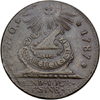 |
1787 Fugio Cent. Pointed rays, cinquefoils, "STATES UNITED". PCGS graded AU-58. Medium brown in color and with some minor weakness on the left side as the coin was struck a touch off-center. Spot-free and pleasing for the grade, and worth a good price for the surfaces.
Estimated Value $1,500 - 2,000.
Purchased from Ira S. Reed, July 1944, for $3.
View details and enlarged photos
| Realized
$1,265 |
Lot 142 |
|
1787 Fugio Cent. Pointed rays, cinquefoils, "STATES UNITED". PCGS graded AU-55. This is the variety with four obverse cinquefoils. Struck from a sharply cracked obverse die from the lower rim towards the sundial. Medium brown and choice surfaces, and this one experienced very little wear. There are some minor planchet streaks on both sides, none deep or offensive.
Estimated Value $1,500 - 2,000.
View details
| Unsold |
Lot 143 |
 |
1787 Fugio Cent. Pointed rays, cinquefoils, "STATES UNITED". Del Bland graded AU-50. With a planchet lamination at K11 on the obverse and a planchet defect at K7 on the reverse edge. Medium chocolate brown and struck from clashed dies. This one could should be examined to enjoy the lovely brown luster and clean surfaces.
Estimated Value $1,000 - 1,500.
View details and enlarged photos
| Realized
$1,150 |
Lot 144 |
|
1787 Fugio Cent. Pointed rays, cinquefoils, "STATES UNITED". AU-50. Medium brown and struck from clashed dies. The planchet has some minor laminations on both sides, and there is a die crack up from the bottom of the reverse rim into the center.
Estimated Value $1,000 - 1,300.
View details
| Realized
$1,093 |
Lot 145 |
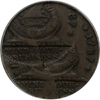 |
1787 Fugio Cent. Pointed rays, cinquefoils, "STATES UNITED" Double Stuck, and how! PCGS graded EF-45. Double Struck, and how! One of the most spectacular error coins we have had the pleasure to offer! The obverse was first struck normally, then the coin was struck again, this time 50% off center towards 11 o'clock. Both strikes are very sharp. On the reverse the second strike is noted more by an arc from the second planchet, and the reverse strike makes it likely that another planchet was beneath this coin. Hence, the rings are flattened out a bit, and no other evidence of the dies striking the reverse are present. We doubt a photograph can do this coin justice, you must see it in person. The color is perfect, medium brown throughout, and no surface porosity is present. As perfect a coin for the collector as we could imagine, unless it was full red, and fresh from the Mint! Make sure to view this piece, even if you have no interest in Colonial issues, it is simply fascinating. Struck by federal contract by James Jarvis's mint at Machin's Mills, Newburgh, New York. The obverse die had cracked severely when this one was struck, with the crack extending up from the rim through the E of BUSINESS and the O of YOUR into the sundial above, the cracked area is plain on both obverse strikes. A few very minor planchet flaws, really just flow lines from the rolling process, and with one dark toning area on the lower left reverse.
Estimated Value $2,000-UP.
View details and enlarged photos
| Realized
$4,140 |
Lot 146 |
 |
1787 Fugio Cent. Pointed rays, cinquefoils, "STATES UNITED". VG-8. Glossy light brown in color and well preserved. Struck on an excellent planchet, but a touch off-center towards the lower obverse, so some of the lettering is weak at the extreme edge. Struck with strongly clashed dies.
Estimated Value $150 - 200.
View details and enlarged photos
| Realized
$414 |
Lot 147 |
 |
1787 Fugio Cent. Pointed rays, cinquefoils, "UNITED STATES". VF-35. Struck slightly off-center towards 9:00 on the obverse, but the lettering and devices are all present. Medium to light brown in color, and struck on a good planchet. Both dies show clash marks. Glossy and choice for the grade.
Estimated Value $500 - 600.
View details and enlarged photos
| Realized
$1,093 |
Lot 148 |
 |
1787 Fugio Cent. Pointed rays, cinquefoils, "UNITED STATES". VF-35. Choice and desirable light tan in color, and well on both sides. There is one minor planchet irregularity near the right cinquefoil, which carries through to the chain on the reverse. Highly desirable and always popular.
Estimated Value $500 - 600.
View details and enlarged photos
| Realized
$2,185 |
Lot 149 |
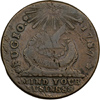 |
1787 Fugio Cent. Club rays, rounded ends. Fine-15. Filled in the lower half of the 8 in the date. Medium brown in color, and with minor planchet streaks and flaws. Well centered and struck, and a nice coin for the type collector.
Estimated Value $450 - 550.
View details and enlarged photos
| Realized
$633 |
Lot 150 |
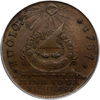 |
1787 Fugio Cent. New Haven "Restrike" in Copper. PCGS graded MS-63 Brown. Struck about 1860. Excellent medium brown chocolate brown surfaces almost free from post striking abrasions. Die cracks on the left obverse.
Estimated Value $400 - 650.
View details and enlarged photos
| Realized
$489 |
|
|